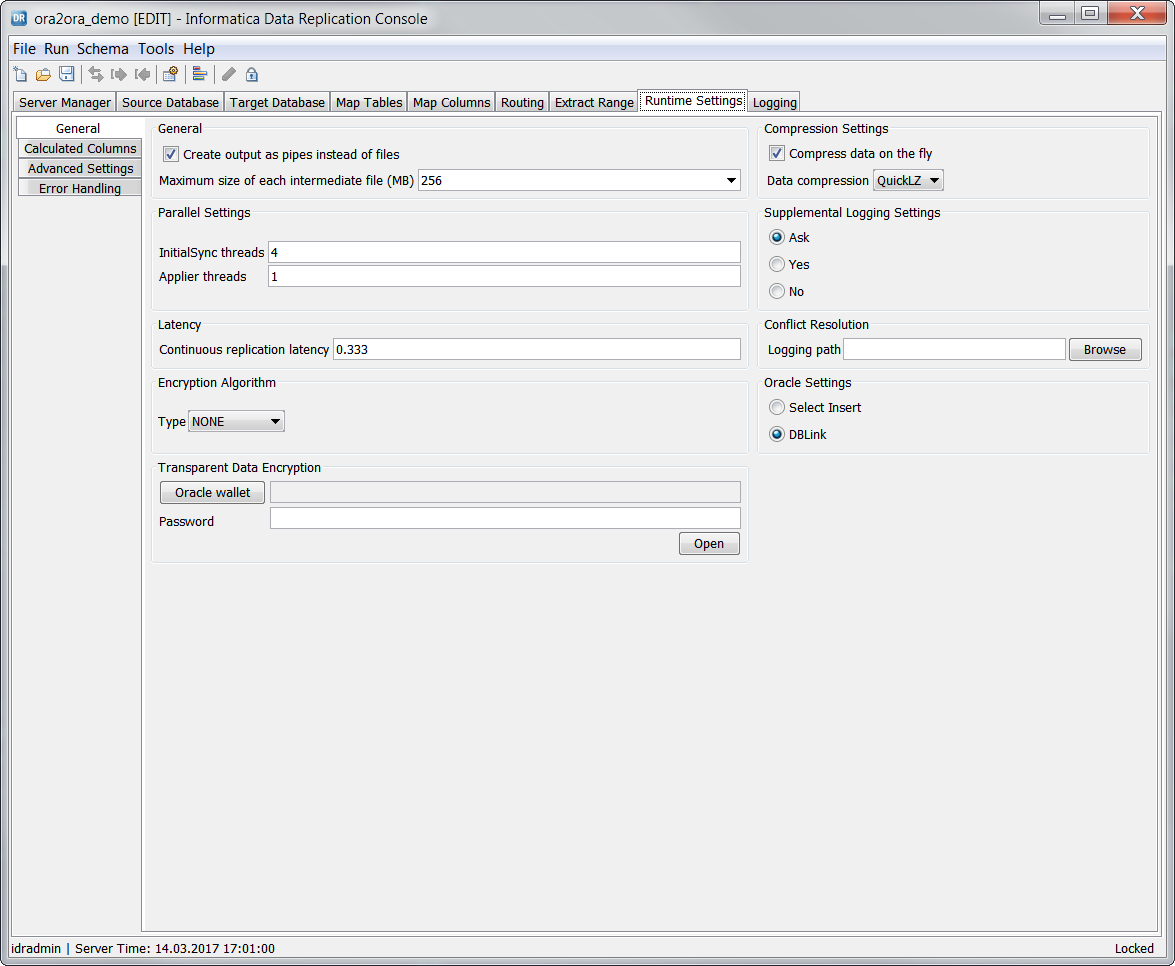Data Replication
- Data Replication 9.8.0 HotFix 2
- All Products


Field
| Description
| Default
|
|---|---|---|
Create output as pipes instead of files
| For InitialSync operations and for change data replication in Merge Apply mode to Netezza targets, select this option to have Data Replication write output to pipes instead of files. Data Replication then loads data from the pipes directly into the targets.
Clear this option to not write data to pipes.
| Selected
|
Maximum size of each intermediate file (MB)
| The maximum amount of data, in megabytes, that you want a single intermediate .DAT file to contain. Options are:
16 ,
32 ,
64 ,
128 ,
256 ,
512 , and
1024 MB.
Data Replication can create a new intermediate file only after the Extractor records a checkpoint. For more information, see
Checkpoint Processing. If the Extractor captures a low volume of change data during a cycle, Data Replication might generate an intermediate file that is smaller than the specified maximum size. If the Extractor captures the maximum amount of data but a checkpoint is not triggered, Data Replication generates an intermediate file that is larger than the specified maximum size.
For Oracle sources, if you set the
extract.use_strict_intermediate_file_size runtime parameter to 1, the Extractor treats the specified maximum size as a hard limit. The Extractor estimates the size of the intermediate file when processing each change record. If the estimated file size exceeds the specified limit, the Extractor forces a checkpoint, writes the data, and closes the intermediate file.
| 256
|
InitialSync threads
| The number of threads for InitialSync parallel processing.
| 4
|
Applier threads
| The number of threads for Applier parallel processing.
| 1
|
Continuous replication latency
| The latency, in seconds, of Extractor change capture processing during continuous data replication. This value determines the duration of an Extractor microcycle. During a microcycle, the Extractor captures changes from database logs, creates an intermediate file, writes changes to the intermediate file, and then sleeps. When the latency period ends, the Extractor begins another microcycle.
When setting the latency period, consider how it affects replication performance:
Default is 0.333 second, which is usually acceptable to process all changes in a microcycle. If necessary, you can adjust the latency in sub-second increments.
After the Extractor creates the intermediate file, the Applier can start reading changes and applying them to the target. Therefore, the Applier might also run during a microcycle. For large transactions with many changes, the Applier waits until the Extractor writes all of the changes to the intermediate file, which might take several microcycles, and then begins apply processing.
| 0.333
|
Encryption Algorithm
| The encryption algorithm that Data Replication uses to encrypt the intermediate files. Options are:
| NONE
|
Oracle wallet
| Oracle sources only. If you have Oracle sources that use Oracle Transparent Data Encryption (TDE), click this button and browse to the Oracle TDE wallet. The wallet must be in PKCS #12 format.
| Not applicable
|
Password
| Oracle sources only. If you specified the Oracle TDE wallet, enter the password for the wallet and click
Open .
| No default
|
Add Certificate
| Microsoft SQL Server sources only. If you have a SQL Server source database that uses Transparent Data Encryption (TDE), click this button and browse to the .pfx certificate file that you copied to the Data Replication installation directory where the Extractor runs.
| Not applicable
|
Edit Certificate
| Microsoft SQL Server sources only. If you added a certificate for an encrypted Microsoft SQL Server database and want to change its path or password, click this button.
| Not applicable
|
Delete Certificate
| Microsoft SQL Server sources only. If you want to delete a certificate that you specified for an encrypted Microsoft SQL Server database, select the certificate and then click this button.
| Not applicable
|
Compress data on the fly
| Select this option to compress intermediate files during extraction processing to reduce the file size.
Clear this option if CPU resources are restricted and you want to avoid the overhead of compression and decompression.
| Selected
|
Data compression
| If you selected
Compress data on the fly , select the compression method. The only available method is
QuickLZ , which provides fast compression with a low compression ratio.
| QuickLZ
|
Supplemental Logging Settings
| Enables database supplemental logging for source tables when you save the configuration. For Oracle sources, generates a supplemental log group for each source table. For DB2 sources, sets the DATA CAPTURE CHANGES option for each source table. For Microsoft SQL Server Sources, sets Change Data Capture for each source table. To control whether the Console automatically enables supplemental logging, select one of the following options:
| Ask
|
Conflict Resolution > Logging path
| The path to the log file to which the Applier logs data conflicts that occur when applying change data to a target on which other change data activity is occurring. Click
Browse to browse to the log file for the system where you run the Applier.
| No default
|
Oracle Settings
| Oracle sources and targets only. Indicates whether to use database links (dblinks) when running InitialSync for an Oracle source and Oracle target. Options are:
This option is a synonym for the
initialsync.oracle.use_dblink parameter, which is set on the
view.
| DBLink
|
Disable secondary truncation checkpoint
| Microsoft SQL Server sources only. Select this option to disable secondary truncation checkpoint management by the Extractor.
Select this option in the following cases:
After you disable Extractor management of the secondary truncation checkpoint, ensure that the Extractor reads both the transaction and backup logs. Otherwise, incomplete data capture can occur.
This option is a synonym for the
extract.mssql.together_with_native_replication parameter on the
view.
| Not selected
|